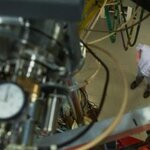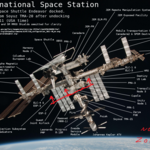Space

Scientists have analyzed extraterrestrial dust hat has settled on ocean floors to determine the amount of heavy elements created by the massive explosions. The dust is thought to be from supernovae, exploding stars way beyond our solar system, and their conclusions are at odds with current theories of supernovae, in which some of the materials essential for human life, such as iron, potassium and iodine are created and distributed throughout space.
The researchers studied plutonium-244 which serves as a radioactive clock by the nature of its radioactive decay, with a half-life of 81…

NASA's Kepler Space Telescope has been hobbled by the loss of critical guidance systems but can still find good stuff - most recently a star with three planets only slightly larger than Earth, one in the "Goldilocks" zone, a region where surface temperatures could be moderate enough for liquid water and therefore perhaps life as we know it, to exist.
EPIC 201367065, is a cool red M-dwarf star about half the size and mass of our own sun. It is 150 light years, making it among the top 10 nearest stars known to have transiting planets. The star's proximity means it's bright enough for…

The International Astronomical Union is holding a competition to assign common names.Astronomy clubs and other public groups may submit names. The general public will then get to vote on proposed names.
The full process is as found on the website. http://www.nameexoworlds.org/
July 2014: a list of 305 well-characterized exoplanets discovered prior to 31 December 2008, is selected for public naming by the International Astronomical Union (IAU) upon the recommendation of its Working Group Exoplanets for the Public. These exoplanets belong to 260 exoplanetary…

NASA’s Dawn mission is closing in on a mysterious, unknown world in the asteroid belt.
The dwarf planet Ceres named after the Roman goddess of agriculture awaits to unlock its secrets.
So far, we’ve only had a glimpse of this enigmatic orb using the Hubble Space Telescope, so it’s more than intriguing what we will find there after Dawn’s arrival. Marc Rayman, the Mission Director and Chief Engineer at NASA’s Jet Propulsion Laboratory, can't hide his contagious excitement: “Everyone should be excited by this.
Everyone who has ever gazed in wonder at the night sky, everyone who yearns to…

A new paper believes that planets outside our solar system - exoplanets - may be a lot more agreeable to life than assumed. The astrophysicists suggest that exoplanets are more likely to have liquid water and be more habitable than we thought.
Scientists have thought that exoplanets behave in a manner contrary to that of Earth - that is they always show their same side to their star. If so, exoplanets would rotate in sync with their star so that there is always one hemisphere facing it while the other hemisphere is in perpetual cold darkness.
The new study suggests, however, that as…

According to Roscosmos an ammonia leak in the US section of the International Space Station has necessitated the evacuation of that section of the station. From what I have read this diagram depicts where the no-go zone is.
Image courtesy of the Russian Space Agency Roscosmos.
To put this in perspective consider the following. If you spill some strong amonia in your house you open a window. In space you cannot do that. So to fix this someone may need to put on a space suit, and work in tight quarters to patch the leak. If the leak cannot be…

The emerging problem of floating space junk becomes more and more evident and bothersome. Spacecraft and satellites are currently subject to high-speed impacts by more than 19,000 trackable objects, mainly old satellites, spent rocket stages, and fragments from disintegration, erosion, and collisions. There are also several hundred thousand objects the size of marbles, and several million the size of sand grains.
Even a tiny piece of debris can inflict considerable damage, or even destroy an orbiting operational spacecraft. A report in 2011 by the National Research Council (NRC) warned…

By observing and surveying 30 cool solar-type stars in the 2.5 Billion-year-old cluster NGC 6819 an international research team has created an analytical procedure for accurately determining the ages of stars with knowledge of their masses and rotation periods.
This "gyrochronology", a neologism of co-author Sydney Barnes, has been shown to work over a wide age range, significantly improving the accuracy of stellar age determination.
"The relationship between mass, rotation rate and age of the observed stars is now defined well enough that by measuring the first two…

A comet is a magical sight in the heavens. Comets visible to the naked eye are a uncommon event, and sometimes they put up very suggestive shows in our skies. Those of us who have witnessed the apparition of a bright comet do not forget that experience easily. The recent landing on comet Churyumov-Gerasimenko of the Rosetta spacecraft has made even more fascinating the observation of comets from the ground, as we got treated by close-ups of the comet surface that resemble mountainous terrains on Earth. Imagining a rock streaming in the sky, coming nearby after a long trip from the Oort…

The gas giant Jupiter safeguards many secrets crucial to our understanding of the evolution of our solar system. It could also provide insights on how giant planets form and the role these titans played in putting together the rest of the solar neighborhood. NASA’s Juno spacecraft is on its way to reveal those mysteries as the probe is on course for its planned arrival at Jupiter on July 4, 2016.
“On that date, Juno will make its first dive over the planet's poles, firing its rocket engine to slow down just enough for the giant planet's gravity to capture the spacecraft into orbit,” Scott…